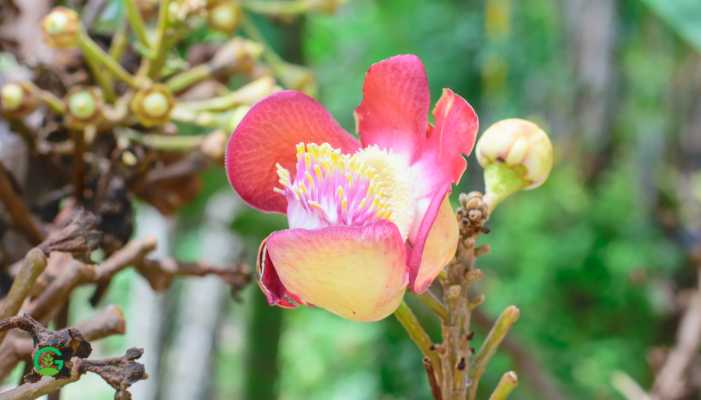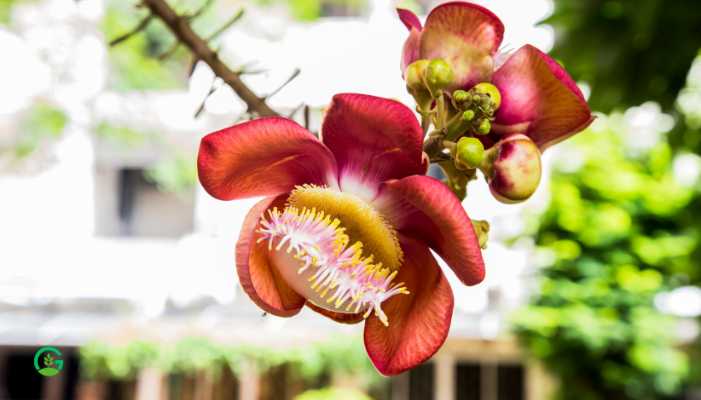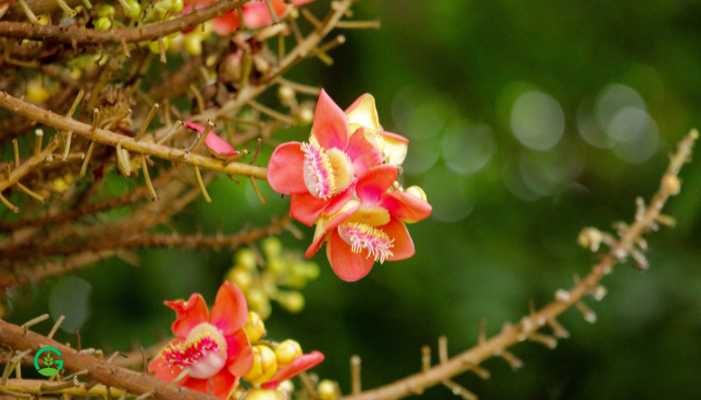Have you ever seen a tree that not only stands out with beauty but also holds deep spiritual significance?
Meet the Nagalinga tree, an incredible natural wonder that has fascinated people for centuries. This tree, with its spectacular flowers and unique cultural significance, is a marvel to behold.
Let’s dive into the world of the Nagalinga tree, unravel its mysteries, and understand why it captivates so many hearts.
Nagalinga Tree Table of Contents
What is the Nagalinga Tree?
The Nagalinga tree, also known as the Cannonball tree (Couroupita guianensis), is an extraordinary plant native to the tropical forests of Central and South America. Its name comes from the fascinating flowers that resemble the sacred Hindu symbol of the lingam, which represents Lord Shiva. The tree is known for its large, spherical fruits that look like cannonballs, hence the name.

The Origin and Distribution
The Nagalinga tree is believed to have originated in the rainforests of the Amazon Basin. It thrives in tropical climates and can be found in countries such as Brazil, Colombia, Venezuela, and Ecuador. Over time, it has been introduced to other parts of the world, including India, Sri Lanka, Thailand, and various regions in Southeast Asia, where it is often planted in temple gardens and parks.
The Botanical Characteristics
Let’s get a bit scientific without getting too complicated. The Nagalinga tree can grow up to 35 meters tall, making it an impressive sight. It has a straight trunk and a dense, rounded canopy. The leaves are large, glossy, and dark green, providing a lush backdrop to the vibrant flowers and fruits.
The flowers are perhaps the most captivating feature of this tree. They bloom directly from the trunk in large clusters, creating a stunning visual effect. The petals are a beautiful mix of pink, red, and yellow, and they emit a sweet, fragrant scent. The tree’s fruits, which resemble rusty cannonballs, can grow up to 25 cm in diameter and contain numerous seeds.
The Unique Flowers
Imagine walking through a garden and stumbling upon a tree with flowers so unique that they almost seem out of this world. The flowers of the Nagalinga tree are exactly that—extraordinary. Each flower is a masterpiece of nature, with a striking resemblance to the sacred lingam, surrounded by a hood-like structure symbolizing the mythical serpent, Naga.
These flowers are not only beautiful but also attract various pollinators like bees and bats. The intricate design and alluring fragrance make the flowers a key element in the tree’s mystique and appeal.

Cultural and Religious Significance
In India and other parts of South Asia, the Nagalinga tree holds a special place in Hindu culture. It is often planted near Shiva temples and is considered sacred. The flowers are used in religious ceremonies and are believed to have spiritual significance.
Have you ever wondered why certain plants are revered in various cultures? The Nagalinga tree is a perfect example of how nature and spirituality intertwine, creating a bond that goes beyond mere admiration of beauty.
Medicinal Uses and Benefits
Nature has a way of surprising us with its hidden treasures, and the Nagalinga tree is no exception. Various parts of the tree have been used in traditional medicine for centuries. The leaves, flowers, and bark are known to have medicinal properties.
Anti-Inflammatory and Antimicrobial Properties
The extracts from the tree are believed to possess anti-inflammatory and antimicrobial properties, making them useful in treating skin infections and wounds.
Pain Relief and Antioxidant Benefits
The leaves and flowers are also used to alleviate pain and provide antioxidant benefits, which help in fighting free radicals in the body.

Ecological Impact
The Nagalinga tree is not just a pretty face; it plays a vital role in its ecosystem. The tree provides a habitat and food for various animals, including birds, insects, and bats. Its flowers attract pollinators, aiding in the reproduction of other plant species in the area.
Additionally, the dense foliage of the tree helps in soil conservation and prevents erosion, making it an important part of maintaining ecological balance.
Growing and Caring for a Nagalinga Tree
If you’re thinking about adding a touch of exotic beauty to your garden, the Nagalinga tree might be just what you need. Here are some tips to help you grow and care for this magnificent tree.
Climate and Soil Requirements
The Nagalinga tree thrives in tropical climates with high humidity and well-drained soil. It prefers full sunlight but can tolerate partial shade.
Planting and Watering
Plant the tree in a spacious area where it has room to grow. Water it regularly, especially during dry periods, but ensure the soil does not become waterlogged.
Pruning and Maintenance
Prune the tree to remove dead or diseased branches and to maintain its shape. Regular maintenance will keep the tree healthy and thriving.
Image | Product Name | Review | Price |
Nagalinga Tree in Art and Literature
The enchanting beauty and unique features of the Nagalinga tree have inspired countless artists and writers. It has been depicted in paintings, poems, and stories, symbolizing various themes such as spirituality, beauty, and nature’s wonders.
Have you ever read a poem that painted a vivid picture in your mind? The Nagalinga tree often serves as a muse, creating imagery that captivates and inspires.
Modern-Day Importance
In today’s world, where urbanization and deforestation are rampant, the Nagalinga tree stands as a symbol of nature’s resilience and beauty. Efforts are being made to conserve this tree and ensure it continues to grace our planet for generations to come.
Challenges and Conservation
Despite its beauty and significance, the Nagalinga tree faces various challenges. Habitat loss, climate change, and overexploitation for medicinal uses threaten its survival. Conservation efforts are crucial to protect this remarkable tree.
Conservation Strategies
Organizations and communities are working together to conserve the Nagalinga tree through initiatives such as planting programs, awareness campaigns, and research on its ecological and medicinal benefits.
Read More
Conclusion
The Nagalinga tree is much more than just a plant; it is a symbol of beauty, spirituality, and ecological significance. Its spectacular flowers, cultural significance, and medicinal properties make it a true wonder of nature. As we continue to discover and appreciate the natural world, let us remember to cherish and preserve the Nagalinga tree and all it represents.
Nagalinga Tree FAQs
Why is the Nagalinga tree considered sacred in Hindu culture?
The Nagalinga tree is considered sacred in Hindu culture because its flowers resemble the sacred lingam, a symbol of Lord Shiva. The tree is often planted near Shiva temples and its flowers are used in religious ceremonies.
What are the medicinal uses of the Nagalinga tree?
The Nagalinga tree has various medicinal uses. Its extracts are believed to have anti-inflammatory and antimicrobial properties, and the leaves and flowers are used to alleviate pain and provide antioxidant benefits.
Where is the Nagalinga tree commonly found?
The Nagalinga tree is native to the tropical forests of Central and South America but can also be found in India, Sri Lanka, Thailand, and other regions in Southeast Asia.
How do you grow and care for a Nagalinga tree?
To grow and care for a Nagalinga tree, plant it in a tropical climate with well-drained soil and full sunlight. Water it regularly and prune to maintain its shape and health.
What ecological role does the Nagalinga tree play?
The Nagalinga tree provides habitat and food for various animals, helps in soil conservation, and supports pollination, playing a vital role in maintaining ecological balance.





















1 thought on “Discover the Enchanting Nagalinga Tree”